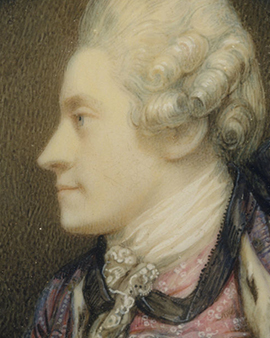Richard Cosway was an English painter who became known during the Regency period primarily for his miniatures and extravagant lifestyle. Richard Cosway showed a great talent for painting at an early age. In 1754, at the age of twelve, he first began training under Hudson, which he soon continued at Shipley's Drawing School. In the years between 1755 and 1760, the Royal Society of Arts awarded his drawings several times. This was followed by numerous exhibitions for the Society of Artists and the Free Society of Artists in the 1760s. In 1769 he joined the Royal Academy, with exhibitions. He was known for his eccentric appearance, arrogance and love of women, although he was also accused of having a feminine side himself. Frequent targets of criticism and ridicule, he and his wife Maria Hadfield, also a painter, were magnets of society, with greats such as William Blake and the dazzling figure of the Chevalier d'Éon frequenting their home. Thomas Jefferson openly harbored a love for Cosway's wife and constantly tried to win her away from him. In 1785, he was appointed court painter Prince of Wales, a title created solely for Cosway, prompting his signature primarius "Pictor Serenissimi Walliae Principis."
Himself a collector of masterpieces of all genres of art, Richard Cosway excelled in his own work, especially in miniature painting. Particularly famous was "Miss Elliot in the Character of Pallas", a miniature he exhibited in 1769 at the Society of Artists, now in the Fondazione Cosway, Lodi. He also produced other works, such as several life-size portraits of the Courtenay family at Powderham Castle, including that of William, 3rd Viscount Courtenay (1791), now in the Lord Courtenay Collection.
Although Richard Cosway also worked in oils, it was his particular technique of miniature painting that made his works stand out. By painting with watercolors on ivory, he achieved a transparent effect that was very different from the tradition. In Cosway's time, miniature painting did not enjoy special recognition, but his works were very well received. His fame and artistic success was probably also due to his skillful self-dramatization and targeted self-promotion. Richard Cosway was a gifted artist who - coming from a humble background - achieved fame and success through talent, a style of his own, the skilful choice of a special niche, as one would say today, and his dazzling appearance. His household was a focal point of London society, where artists, intellectuals and people of influence frequented.
×





.jpg)
.jpg)
.jpg)
.jpg)
.jpg)
.jpg)
.jpg)
.jpg)
.jpg)
.jpg)
.jpg)
.jpg)
_-_(MeisterDrucke-932250).jpg)
_-_(MeisterDrucke-932250).jpg)
 - (MeisterDrucke-305037).jpg)
 - (MeisterDrucke-305037).jpg)
_Countess_of_Hopetoun_1789_(wc_und_gouache_on_ivory)_-_(MeisterDrucke-101191).jpg)
_Countess_of_Hopetoun_1789_(wc_und_gouache_on_ivory)_-_(MeisterDrucke-101191).jpg)
 - (MeisterDrucke-186630).jpg)
 - (MeisterDrucke-186630).jpg)
_-_(MeisterDrucke-1283871).jpg)
_-_(MeisterDrucke-1283871).jpg)
.jpg)
.jpg)
.jpg)
.jpg)
 179 - (MeisterDrucke-235079).jpg)
 179 - (MeisterDrucke-235079).jpg)
.jpg)
.jpg)
 3rd Earl of Hopetoun 1789 - (MeisterDrucke-589399).jpg)
 3rd Earl of Hopetoun 1789 - (MeisterDrucke-589399).jpg)
.jpg)
.jpg)
 - (MeisterDrucke-249096).jpg)
 - (MeisterDrucke-249096).jpg)
 engraved by Antoine or Anthony Cardon (1772-1813) 1804 - (MeisterDrucke-116166).jpg)
 engraved by Antoine or Anthony Cardon (1772-1813) 1804 - (MeisterDrucke-116166).jpg)
.jpg)
.jpg)
.jpg)
.jpg)
.jpg)
.jpg)
.jpg)
.jpg)
.jpg)
.jpg)
.jpg)
.jpg)
.jpg)
.jpg)
.jpg)
.jpg)
.jpg)
.jpg)
.jpg)
.jpg)
.jpg)
.jpg)
.jpg)
.jpg)
.jpg)
.jpg)
.jpg)
.jpg)
.jpg)
.jpg)
.jpg)
.jpg)
.jpg)
.jpg)
_-_(MeisterDrucke-1089620).jpg)
_-_(MeisterDrucke-1089620).jpg)
.jpg)
.jpg)
.jpg)
.jpg)
.jpg)
.jpg)
.jpg)
.jpg)
.jpg)
.jpg)
.jpg)
.jpg)
.jpg)
.jpg)
.jpg)
.jpg)
.jpg)
.jpg)
 - (MeisterDrucke-248237).jpg)
 - (MeisterDrucke-248237).jpg)
.jpg)
.jpg)
.jpg)
.jpg)
.jpg)
.jpg)
_-_(MeisterDrucke-1132451).jpg)
_-_(MeisterDrucke-1132451).jpg)
.jpg)
.jpg)
 - (MeisterDrucke-152319).jpg)
 - (MeisterDrucke-152319).jpg)
.jpg)
.jpg)
.jpg)
.jpg)
.jpg)
.jpg)
.jpg)
.jpg)
.jpg)
.jpg)
.jpg)
.jpg)
.jpg)
.jpg)
.jpg)
.jpg)
.jpg)
.jpg)
.jpg)
.jpg)
.jpg)
.jpg)
.jpg)
.jpg)
 - (MeisterDrucke-144426).jpg)
 - (MeisterDrucke-144426).jpg)
.jpg)
.jpg)
.jpg)
.jpg)
.jpg)
.jpg)
.jpg)
.jpg)
.jpg)
.jpg)
.jpg)
.jpg)
.jpg)
.jpg)
.jpg)
.jpg)
.jpg)
.jpg)
.jpg)
.jpg)
.jpg)
.jpg)
.jpg)
.jpg)
.jpg)
.jpg)
.jpg)
.jpg)
.jpg)
.jpg)
.jpg)
.jpg)
.jpg)
.jpg)
_-_(MeisterDrucke-1132480).jpg)
_-_(MeisterDrucke-1132480).jpg)
.jpg)
.jpg)
.jpg)
.jpg)
_on_ivory_-_(MeisterDrucke-1107084).jpg)
_on_ivory_-_(MeisterDrucke-1107084).jpg)
.jpg)
.jpg)
.jpg)
.jpg)
_-_(MeisterDrucke-1108207).jpg)
_-_(MeisterDrucke-1108207).jpg)
.jpg)
.jpg)
.jpg)
.jpg)
.jpg)
.jpg)
_-_(MeisterDrucke-1427146).jpg)
_-_(MeisterDrucke-1427146).jpg)
.jpg)
.jpg)
.jpg)
.jpg)
.jpg)
.jpg)
.jpg)
.jpg)
_-_(MeisterDrucke-1120533).jpg)
_-_(MeisterDrucke-1120533).jpg)
.jpg)
.jpg)






